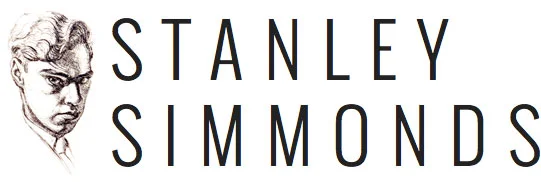Stanley Simmonds was born in 1917 in Droitwich, Worcestershire, the youngest of three brothers. His father was a relief GWR signalman and his mother a dressmaker.
Having attended Birmingham College of Art, Stanley saw wartime service in the Royal Navy, where he made a life-long friend of the Cornish poet, Charles Causley. After the war he resumed his studies at the Royal College of Art in 1946. His paintings at this time were beautifully executed tonal studies of nudes, still-lives and rural subjects. The sensitive portrait of his wife Cynthia Kathleeen King, also a painter, whom he married in c.1950 sees him freshly graduated from the Royal College of Art.
He settled into married life in London, in a roomy flat at 22 Redcliffe Square, SW10 and immediately on leaving the Royal College got his first job as art teacher at the Chislehurst and Sidcup Grammar School, where he stayed for 30 years as a much respected teacher who also staged and designed the costumes and settings for many of the school plays. His most famous pupil was the illustrator Quentin Blake with whom he exhibited at Hertford College, Oxford in 1963.
From the late 1950s to the 1970s Stanley’s career flourished. From 1958 to 1962 he had a series of successful exhibitions at the innovative Bear Lane Gallery in Oxford where he showed alongside leading artists like, Ivon Hitchens, Keith Vaughan, John Bratby, John Piper and many others and his work found its way into many of the college collections. These shows received complimentary reviews by distinguished critics; John Hale in Arts News and Review and Terrence Mullaly of The Telegraph. He exhibited mainly figurative work, landscapes and architectural subjects with a strong sensitivity towards colour and form.
Around this time he also embarked on a remarkable series of paintings of Billingsgate Market which represented a more personal exploration for him. Rising early in the mornings, he executed rapid pencil sketches of the porters and carters, unloading the heavy boxes of fish. His paintings of the market document his journey from figuration through to abstraction, exploring blocks of colour and tonal valuation but all imbued with the light and atmosphere of the market at dawn. An important painting from this series is in the collection of the Herbert Gallery, Coventry and others remain with the family.
Like many Modern British artists of his generation, Stanley was becoming increasingly attracted to abstraction which took many different forms, some of the canvases dissolve in a luminous atmospheric interpretation of the landscape the paint scummbled and glazed, others are much more tightly constructed with strong cubist shapes, bold colours and flat blocks of colour. He was drawing on a wide range of contemporary influences. There are elements of the neo-romantics like Keith Vaughan, Michael Ayrton and Graham Sutherland - and from further afield Mark Rothko and the Colour Field artists. In the most successful of them, Stanley forged a vision and style uniquely his own combining abstraction and figuration.
Following his retirement, Stanley moved to Launceston in Cornwall to be near his great friend the poet Charles Causley in the late 1970s, and the 1980s saw a return to a more figurative style with successful exhibitions at the Somerville Gallery in Plymouth and Exeter University. He was a prodigious artist working in his studio, a converted chapel in South Petherwin, near Launceston.
Quentin Blake writes of Stanley
‘He was enormously helpful and valuable to me, as I am sure he was to many others, because his commentary on your work was not a question of marks and assessment but an adult exchange about what you had actually done.
The Billingsgate paintings were evidently the fruit of many studies made on site; but it wasn’t, you felt, the detail of everyday life that took the artist’s attention as much as, together with substantial reality, the architecture of forms supplied by the porters and their surroundings.
Those pictures were soon followed by a remarkable development into abstraction. What was formerly substance becomes atmosphere. It is a world of movement, distance, luminosity, but one which the architecture of the canvas is still disposed with authority.’
While contemporary critics commented on and praised his work:
G M Butcher in the “Guardian” wrote "...distinctly exciting that work by Simmonds in which his sensibility blossoms forth into an inherent logic of its own."
John Hale in the 'Arts News Review', "Singled out Simmonds work" (from a mixed exhibition) as "outstanding" and wrote of "the delicacy and relish" of the painter’s reaction to certain visual experience.
Terence Mullaly of 'The Telegraph' wrote of Simmonds’s work as combining "a sure sense of design with colouring that succeeds in suggesting an element of mystery."

